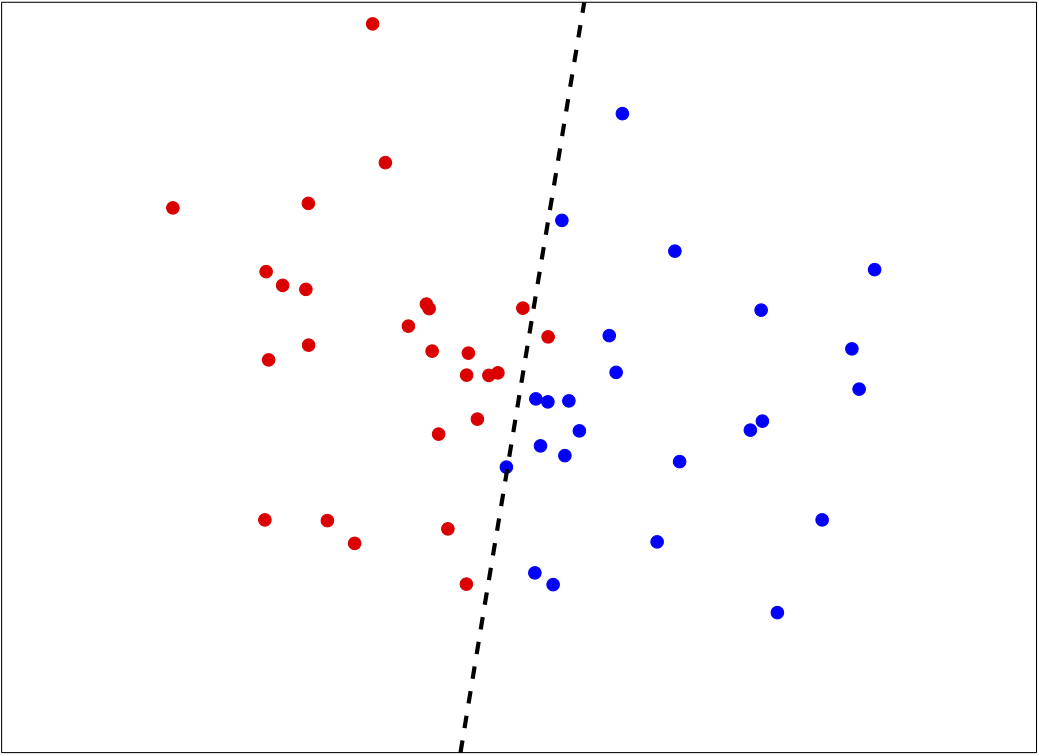Convolutional Neural Network
Hao Su
Fall, 2021
Many slides are from Stanford CS231n
Agenda
Limitations of Linear Classifiers
Recap: Linear Classifier
\[
f_{W,b}(x)=\underbrace{W}_{10\times 3072}\quad \underbrace{x}_{3072\times 1}+\underbrace{b}_{10\times 1}
\]
Recap: Loss Functions
Given a training dataset $\{(x_i,y_i)\}_{i=1}^n$.
- $f(x;\theta)$ to denote the classifier (e.g., linear classifier) parameterized by $\theta$.
- $f_i(x;\theta)$ to denote the score for the $i$-th class
- Then the loss function is \[ L(\theta)=-\frac{1}{n}\sum_{i=1}^n \log \left(\frac{e^{f_{y_i}(x_i;\theta)}}{\sum_j e^{f_j(x_i;\theta)}}\right) \]
Problem: Linear Classifiers are not very powerful
Linear classifiers only work when data points are
Examples of linearly separable versus linearly non-separable:
linearly separable.
Examples of linearly separable versus linearly non-separable:
linearly separable
linearly non-separable
Motivation of Feature Extraction

Image Feature Extraction

Neural Networks
The Original Linear Classifier
(Before) Linear score function: $f=Wx$, where $x\in\R{D}$, $W\in\R{C\times D}$
In practice, we will usually add a bias term.
2-Layer Network
(Before) Linear score function: $f=Wx$, where $x\in\R{D}$, $W\in\R{C\times D}$
(Now) 2-layer Neural Network: $f=W_2\max(0, W_1x)$, where $x\in\R{D}$, $W_1\in\R{H\times D}$, $W_2\in\R{C\times H}$
In practice, we will usually add a bias term at each layer, as well.
(Now) 2-layer Neural Network: $f=W_2\max(0, W_1x)$, where $x\in\R{D}$, $W_1\in\R{H\times D}$, $W_2\in\R{C\times H}$
3-Layer Network
(Before) Linear score function: $f=Wx$, where $x\in\R{D}$, $W\in\R{C\times D}$
(Now) 2-layer Neural Network: $f=W_2\max(0, W_1x)$, where $x\in\R{D}$, $W_1\in\R{H\times D}$, $W_2\in\R{C\times H}$
In practice, we will usually add a bias term at each layer, as well.
(Now) 2-layer Neural Network: $f=W_2\max(0, W_1x)$, where $x\in\R{D}$, $W_1\in\R{H\times D}$, $W_2\in\R{C\times H}$
or 3-layer Neural Network: $f=W_3\max(0,W_2\max(0,W_1x))$
Hierarchical Computation
2-layer Neural Network: $f=W_2\max(0, W_1x)$

- All dimensions of $h$ are computed from all dimensions of $x$; and all dimensions of $s$ are computed from all dimensions of $h$.
- $W_1$ and $W_2$ are also called fully-connected layers (FC layers), and the network is also called a multi-layer perceptron (MLP).
Why is $\max$ Operator Important?
(Before) Linear score function: $f=Wx$
(Now) 2-layer Neural Network: $f=W_2\fcolorbox{blue}{white}{$\max(0,$} W_1x)$
The function $\max(0,z)$ is called the activation function.
(Now) 2-layer Neural Network: $f=W_2\fcolorbox{blue}{white}{$\max(0,$} W_1x)$
The function $\max(0,z)$ is called the activation function.
Q: What if we try to build a neural network without activation function?
\[
f=W_2W_1x
\]
A: Let $W_3=W_2W_1\in\R{C\times H}$, then $f=W_3x$. We ended up with a linear classifier again!
$\max$ operator introduces non-linearity!
Activation Functions

ReLU is a good default choice for most problems
Example Feed-Forward Computation
of a Neural Network

[REPLACE BY A TORCH CODE SNIPPET]
# forward-pass of a 3-layer neural network:
f = lambda x: 1.0 / (1.0 + np.exp(-x)) # activation function (use sigmoid)
x = np.random.randn(3, 1) # random input vector of three numbers (3x1)
h1 = f(np.dot(W1, x) + b1) # calculate first hidden layer activations (4x1)
h2 = f(np.dot(W2, h1) + b2) # calculate second hidden layer activations (4x1)
out = np.dot(W3, h2) + b3 # output neuron (1x1)
Learning a Neural Network: Log-Likelihood Loss (Recall)
Given a training dataset $\{(x_i,y_i)\}_{i=1}^n$.
- $f(x;\theta)$ to denote the classifier (e.g., linear classifier) parameterized by $\theta$.
- $f_i(x;\theta)$ to denote the score for the $i$-th class
- Then the loss function is \[ L(\theta)=-\frac{1}{n}\sum_{i=1}^n \log \left(\frac{e^{f_{y_i}(x_i;\theta)}}{\sum_j e^{f_j(x_i;\theta)}}\right) \]
$\theta$: Weights $W_i$ and $b_i$ in all neural network layers
Learning a Neural Network: Optimization (Recall)
\[
L(\theta)=-\frac{1}{n}\sum_{i=1}^n \log \left(\frac{e^{f_{y_i}(x_i;\theta)}}{\sum_j e^{f_j(x_i;\theta)}}\right)
\]
Stochastic Gradient Descent (SGD)
- A very simple modification to GD
- At every step, randomly sample a minibatch of data points (e.g., 256 data points)
- Compute the average gradient on the minibatch to update $\theta$
Back-Propagation
- So we need to compute the gradient of the neural network.
- For example, in a 2-layer neural network \[ f_{W_1, W_2}(x)=W_2\max(0,W_1x), \] we need to compute the partial gradients with respect to each weight in $W_i$'s.
- Gradient computation uses the chain rule of differentiation: \[ g(h(\theta_i))=\frac{\partial g}{\partial h}\frac{\partial h}{\partial \theta_i} \]
- In network training, gradient computation by chain rule is called error back-propagation.
Back-Propagation: Example Code
[ADD PYTORCH CODES HERE]
Full Implementation of Training a Neural Network
[REPLACE BY TORCH CODE]


Universal Approximation
Decision Boundaries of Linear Classifiers
- Let us first restrict the discussions to binary classification
- Recall that, the decision boundary of a linear classifier can only be straight lines.

Decision Boundaries of Neural Networks
Consider the 2-layer neural network:
\[
f_{W_1, W_2}(x)=W_2\max(0,W_1x),
\]

Decision Boundaries of Neural Networks
- We are able to create a very complex decision boundary by even a 2-layer neural network
- In the following example, all the training data will have correct label predictions with 20 hidden neurons

In fact, for any given dataset with non-conflicting labels, we can always add enough hidden neurons so that all the training data can be predicted correctly (but may fail on test data).
Bias and Variance
End